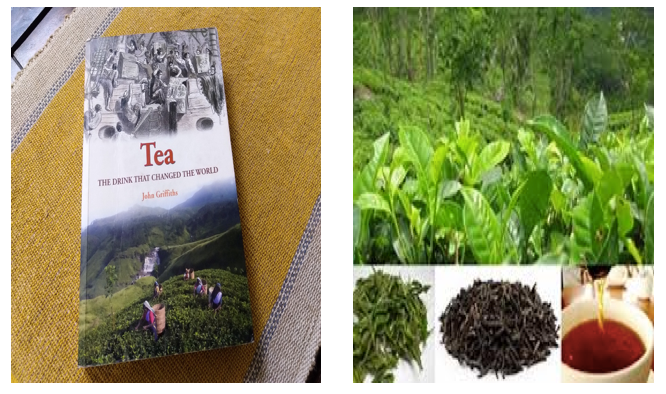[Originally published as part of my Column “Green Cardamoms “ in Shillong Times, Canvas, page 3].
A story in a tea cup
Author: Gaurangi Maitra

Photo credit : www.gaurangimaitra.com & www.krishijagaran.com
Memory tags: On buying Tea: A History of the Drink That Changed the World by John C.Griffith, in Tezpur, Assam.
Human travellers and migrations have woven new patterns into the lives of plants, animals and given civilization, commerce and palette unconventional dialogues. Say ‘Assam’ in a global context and the immediate single synonym is tea, not rhododendron, rhinocerous, bamboo or Brahmaputra. An initially British cuppa born out of commercial necessity, insatiable demand, escalating payment in silver, fallout from wars and political games and crucially, as an alternative to tea imported from China. Half a century after Plassey, the British were well entrenched in India and had their ubiquitous travellers reporting from all corners of the subcontinent. That the Shingpo - Kochin tribesmen on the Assam-Upper Burma brewed a drink from the leaves of Camellia sinensis var. assamica was first reported by Major Robert Bruce in 1823.Oddly enough at that point of time the Assam variety of the tea plant did not have this definitive nomenclature, it was just one of the hundred odd camellias known to science. What set tea cultivation apart in Northern India (read mainly Assam ) was it did not begin in terrain familiar under spice or coffee plantations. Tea plantation in Assam was no well planned strategy but carried out in fits and starts on new lands to be cleared and tamed by aliens in an alien territory. At that time, the world knew no ‘Assam Tea’ as we know it today, it was all and only China. Right from the very beginning Assam Tea had a character all its own. It grew on the plains right beside the rice paddy hollows not on hillsides as in Nilgiris and Ceylon. Unlike China where it was grown on small acreage plots by the owners, in Assam large companies owned the plantations with their representative in the field, ‘the Planter Sahib’ commanding a brigade of workers. The latter was Mai Baap or loco parentis to disparate workers often forcibly recruited from outside the region including China, with whom he shared very little in common. This immigrant labour community would lead to episodic violent ethnic cleansing in Assam (and Sri Lanka) in the future. John Griffiths writes in his very well researched and readable book "Tea, The Drink That Changed The World", as a plantation crop cultivated on funds put up by the shareholders of the Assam Tea Company(1838), Jorhaut Company(1859) and Nowgong Tea Company(1863), it had to give back standardised, predictable returns and stop resembling a game of snakes and ladders. So the world’s second tea research centre, the Tocklai Experimental Station, was set up in the Jorhat district of Assam in 1911. It carried forward the work of the Scientific Department of the Indian Tea Association begun in 1900. This was only natural in a century where scientific methods were the final arbiters of most things under the sun ,so soil, moisture, fertilizers, seed, plant, harvesting, pests to packaging of product for tea would gather scientific moss from this and other sources. Infact the concept of having trees to shade tea bushes originated in Assam in the last decades of the 1800s. And unlike the near monoculture of Silver Oak, Grevillea robusta in Southern Indian plantations, Assam tea gardens mix four or five species of trees, with the original white flowered Siris, Albizzia chinensis being the most common. Assam would in future become the worlds’ single largest tea growing area. When all parameters were factored in, Camellia sinensis var. assamica produced much more leaf than the Chinese variety that the first planters were bent on introducing. So today, India is exporting 2 million kgs of tea to China for the younger generation hung up on tea bag culture, an innovation begun in the US of A! The website of the Tocklai Experimental Centre showcases its advisory that covers 3,41,049 ha of land spread over the Brahmaputra South Bank, Brahmaputra North Bank, Upper Assam, Cachar in Assam, Tripura in Agartala, Dooars in Assam and Bengal, Darjeeling in Bengal and the Nepal Terai covering 1076 tea plantations. When such a large area is given over to tea plantation, an accompanying change in the natural, agricultural, ethnic, social and political landscape is inevitable, especially in Assam, the heartland.
Thus when the impatient gap between waiting for a flight at LGB International Airport, Guwahati in Assam and a business meeting is the only window through which the identity of a new place can be assimilated; then hoardings of Assamese damsels dancing in traditional finery against a background of tea gardens merging into the rhino land of Kaziranga are instant upload of identities. This is reinforced by the souvenir and handicraft shops marketing identities in 3D take away. Conversely, the same technology allows dissemination of virtual and real travel experience on a unprecedented scale. An entire microcosm of regional experience can be telescoped into a 48 hr weekend, where it would have taken the same time in days to reach the destination. All this and more for a cup has attained its near omnipresent proportions, in India and the world over.
Main resources:
- Tea: A History of the Drink That Changed the World by John C.Griffith,
- The website of the Tocklai Experimental Centre
